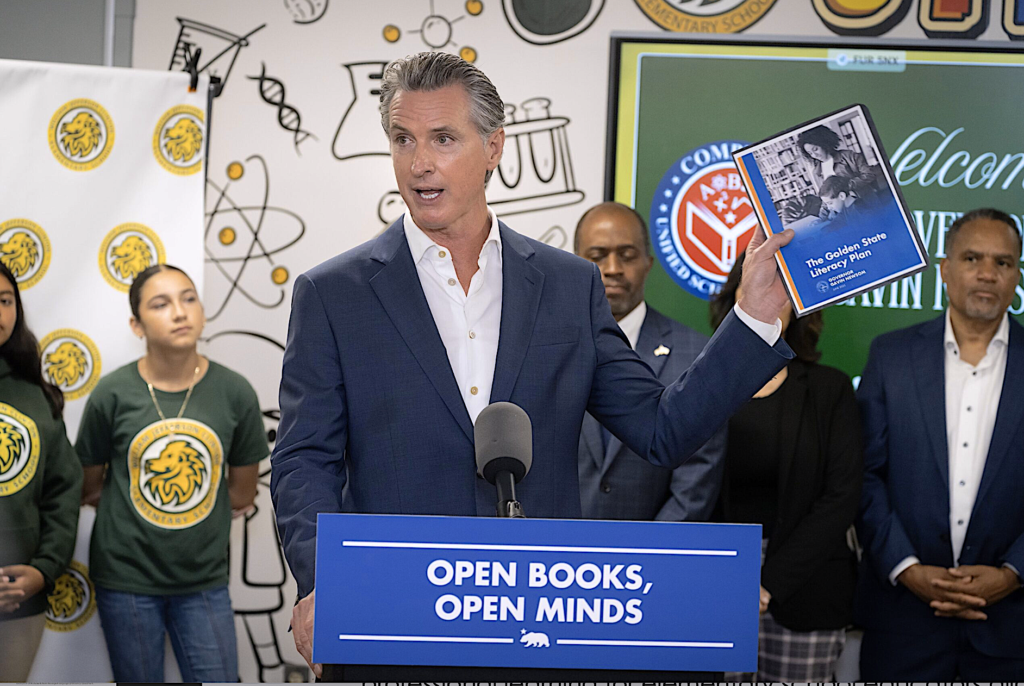
Gov. Gavin Newsom displays the Golden State Literacy Plan, a compilation of actions he has taken to improve reading in early grades, during an appearance at Clinton Elementary School in Compton on June 5.
California Gov. Gavin Newsom confirmed Thursday that the state budget will include hundreds of millions of dollars to fund legislation needed to achieve a comprehensive statewide approach to early literacy.
Assembly Bill 1454, which passed the Assembly on Thursday with a unanimous 75-0 vote, would move the state’s schools toward adopting evidence-based literacy instruction, also known as the science of reading or structured literacy.
Although phonics, the ability to connect letters to sounds, has drawn the most attention, the science of reading focuses on four other pillars of literacy instruction: phonemic awareness, identifying distinct units of sounds; vocabulary; comprehension; and fluency. It is based on research on how the brain connects letters with sounds when learning to read.
“Learning to read is life-changing for a child,” Assembly Speaker Robert Rivas, D-Salinas, said in a statement. “And strong reading skills are the gateway to academic success, lifelong confidence, and opportunity. With this legislation, we take a clear and necessary step toward ensuring every child in California learns to read, and read well. This bill is supported by a broad and growing coalition all united in one belief: That we can and must do better for our students.”
Rivas forged a deal for AB 1454 after ordering the sponsors of the bill, which included advocacy groups Decoding Dyslexia CA, EdVoice, and Families In Schools, to settle their differences with advocates for English learners and the California Teachers Association.
The compromise legislation would provide funding for optional teacher training in evidence-based practices, require that all TK-5 textbooks that districts adopt be aligned to in this approach, and ensure all newly credentialed administrators are trained to support evidence-based instruction.
Assemblymembers Blanca Rubio, D-Baldwin Park, and Al Muratsuchi, D-Torrance, co-authored the bill.
“We attached that bill to the budget, so we mean business,” Newsom said during a press conference at Clinton Elementary School in Compton. “We wanted to get that done, and we got it done. We hope we’ll get it done with an additional $200 million attached to it.”
Advocates of a comprehensive statewide approach to early literacy say the bill would fill in significant gaps in the state’s current policy of local control over instructional decisions. It completes a comprehensive plan to improve literacy in the state, said Newsom, introducing the Golden State Literacy Plan.
“This Golden State Literacy Plan is a step-by-step plan to make real what we are promoting,” Newsom said, holding up the nine-page document — a compilation of actions the state has taken, culminating with additional funding for literacy-related programs and actions.
While states like Mississippi, Tennessee and Colorado have started with a framework grounded in the science of reading and a comprehensive plan for early literacy, California, over the past five years, adopted disparate parts: new evidenced-based reading standards for teacher preparation programs, state funding of an early grade diagnostic screening system for reading challenges like dyslexia, and funding reading coaches in the state’s lowest-performing schools. It also included the expansion of transitional kindergarten and expanded bilingual programs.
Newson talked about his personal experience with dyslexia and how it has motivated him to improve literacy in the state.
“There’s not a day where my dyslexia does not expose itself,” he said. “If anyone’s seen my writing, they can attest to how it exposes itself. So this has been an imperative for me to do more and do better in this space.”
Newsom also took the opportunity Thursday to talk about some of the state’s successes, including improved scores on the National Assessment of Educational Progress in reading in both fourth and eighth grades between 2011 and 2022.
The Compton Unified School District was selected for the press conference to highlight the district’s increased test scores and graduation rates.
“Today’s event reflects a shared purpose, ensuring literacy for all,” said Compton Unified Superintendent Darin Brawley. “The governor’s emphasis on literacy is both timely and essential. Research and experience tells us that if students are not reading by grade three, it’s going to be a struggle. Thereafter, their academic path becomes increasingly difficult.”
Compton Unified has worked to eliminate the opportunity gap by expanding access to early literacy programs, multilingual education and STEAM pathways, he said.
“Compton Unified is proof that demographics do not determine destiny,” Brawley said. “With the right investments, the right leadership, the right vision, the right partnerships, we can transform outcomes and unlock the full potential of every single child.”
Martha Hernandez, executive director of Californians Together, which advocates for English learners, said the state literacy plan supports a diverse student population. The organization, which had opposed the original bill, was satisfied that the materials and training in the new bill would incorporate the specific literacy needs of English learners.
“The recently launched literacy and biliteracy resources, the literacy content blocks and the preschool through third-grade learning progressions provide critical guidance to help educators support young learners in both English and their home language,” Hernandez said. “Thank you, Governor Newsom, for ensuring that multilingual learners are at the center of California’s literacy promise.”
The Golden State Literacy Plan also highlights the state’s investments in literacy in the governor’s upcoming budget, including $1.7 billion for a block grant to fund professional development for teachers, $500 million for TK-12 literacy and math coaches, $387.6 million for additional Learning Recovery Emergency Block Grant funding, $40 million to support literacy screenings, and $25 million to support implementation of math and literacy initiatives, elevate best practices, and establish a clearinghouse for state-developed math and literacy resources.
The increased state funding for literacy comes amid criticism of Newsom’s spending plan for education, which the Legislative Analyst’s Office has said will create new debt and rely on one-time funding to pay for ongoing operations.
John Fensterwald contributed to this report.

دیدگاهتان را بنویسید